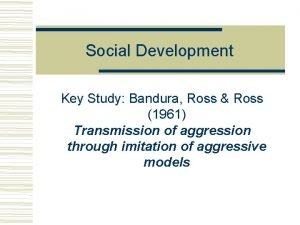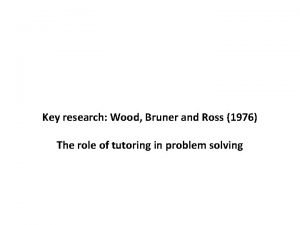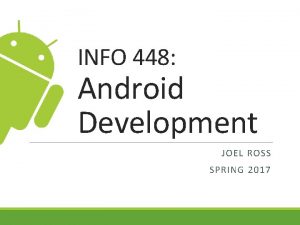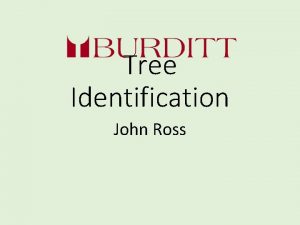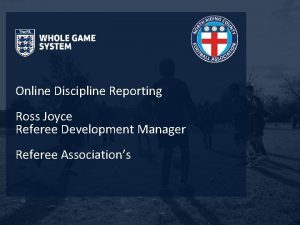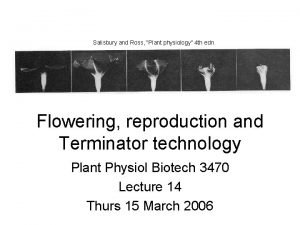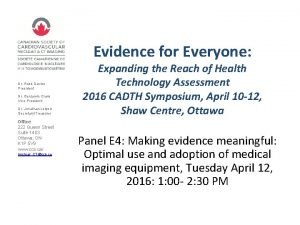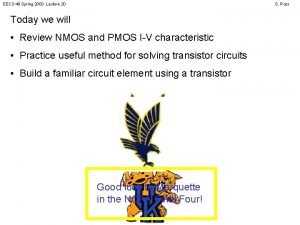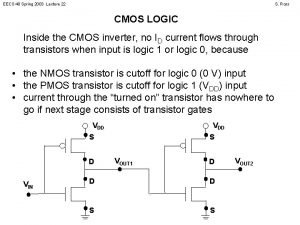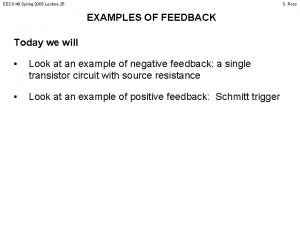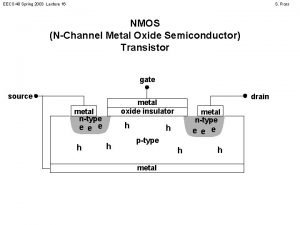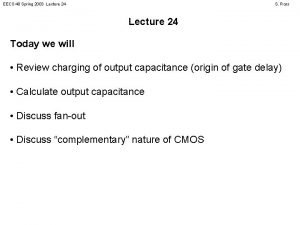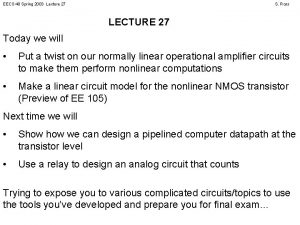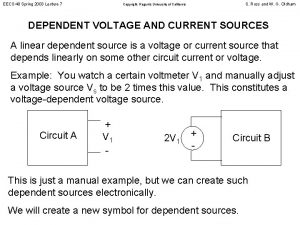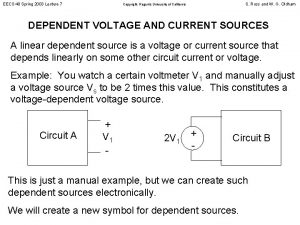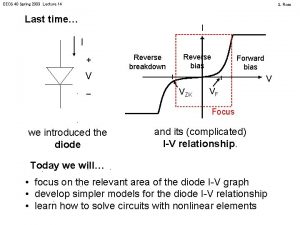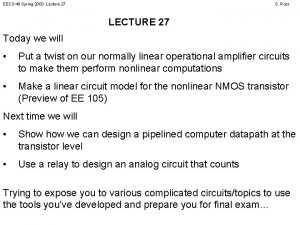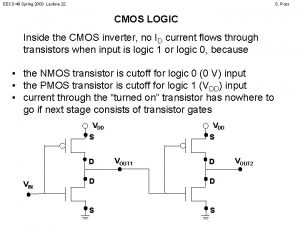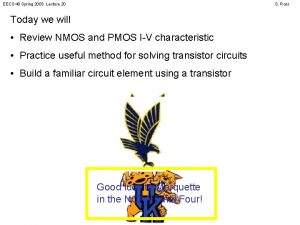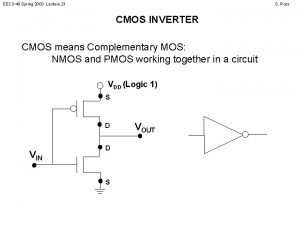EECS 40 Spring 2003 Lecture 21 S Ross
















- Slides: 16

EECS 40 Spring 2003 Lecture 21 S. Ross CMOS INVERTER CMOS means Complementary MOS: NMOS and PMOS working together in a circuit VDD (Logic 1) S D VIN D S VOUT

EECS 40 Spring 2003 Lecture 21 S. Ross CMOS INVERTER RESPONSE VOUT VDD VM: Voltage when VIN = VOUT (= VM) A B C D E VIN VDD

EECS 40 Spring 2003 Lecture 21 S. Ross LAST TIME: SINGLE TRANSISTOR CIRCUIT ID triode mode saturation mode VGS = 3 V X VDS = VGS - VTH(N) Linear ID vs VDS given by surrounding circuit X VGS = 1 V VDS

EECS 40 Spring 2003 Lecture 21 S. Ross ANALYSIS OF INVERTER CIRCUT Obtain: 1) the two nonlinear ID vs. VDS equations for the transistors: ID(N) vs. VDS(N) and ID(P) vs. VDS(P) 2) A linear relationship between ID(N) and ID(P) (e. g. , via KCL) 3) An independent linear relationship between VDS(N) and VDS(P) (e. g. via KVL) Using the above, write: ID(P) vs. VDS(P) in terms of ID(N) vs. VDS(N) (or vice-versa) Solve the two transistor equations simultaneously.

EECS 40 Spring 2003 Lecture 21 S. Ross ANALYSIS OF INVERTER CIRCUIT: UNLOADED VDD (Logic 1) S D VIN VOUT D S 1) Transistor equations: ID(N) = f. N(VDS(N)) ID(P) = f. P(VDS(P)) 2) ID(P)+ID(N) = 0 3) VDS(N)-VDS(P) = VDD Rewrite 1) as ID(N) = -f. P(VDS(N)-VDD) Find simultaneous solution to: ID(N) = f. N(VDS(N)) ID(N) = -f. P(VDS(N)-VDD)

EECS 40 Spring 2003 Lecture 21 S. Ross ANALYSIS OF INVERTER CIRCUIT: UNLOADED (P) - GS V + VDD (Logic 1) Also note: S VGS(N) = VIN VOUT D D VIN +V GS(N ) - S + VDS(N) _ VGS(P) = VIN - VDD VOUT = VDS(N)

EECS 40 Spring 2003 Lecture 21 S. Ross CMOS INVERTER: REGION A ID VDS(P) = VGS(P) - VTH(P) VGS(N) < VTH(N) VGS(P) < VTH(N) - VDD No current flow in Region A! NMOS cutoff mode PMOS triode mode VDS VDD

EECS 40 Spring 2003 Lecture 21 S. Ross CMOS INVERTER: REGION B ID VGS(N) = VTH(N) + e VDS(P) = VGS(P) - VTH(P) VGS(P) = VTH(N) + e - VDD NMOS saturation mode PMOS triode mode VDS(N) = VGS(N) - VTH(N) VDS VDD

EECS 40 Spring 2003 Lecture 21 S. Ross CMOS INVERTER: REGION C ID NMOS saturation mode PMOS saturation mode VDS(P) = VGS(P) - VTH(P) VDS(N) = VGS(N) - VTH(N) VDS VDD

EECS 40 Spring 2003 Lecture 21 S. Ross CMOS INVERTER: REGION D ID VGS(N) = VDD + VTH(P) - e VGS(P) = VTH(P) - e VDS(N) = VGS(N) - VTH(N) NMOS triode mode PMOS saturation mode VDS(P) = VGS(P) - VTH(P) VDS VDD

EECS 40 Spring 2003 Lecture 21 S. Ross CMOS INVERTER: REGION E ID VGS(N) > VTH(P) + VDD VGS(P) > VTH(P) VDS(N) = VGS(N) - VTH(N) No current flow in Region E! NMOS triode mode PMOS cutoff mode VDS VDD

EECS 40 Spring 2003 Lecture 21 S. Ross CMOS INVERTER RESPONSE: CURRENT FLOW ID A B C D E VIN VDD

EECS 40 Spring 2003 Lecture 21 S. Ross • No ID current flow in Regions A and E if nothing attached to output; current flows only during logic transition • If resistor or diode attached to output, current will flow through PMOS when input is low (output is high) • If another inverter (or other CMOS logic) attached to output, transistor gate terminals of attached stage do not permit current: current flows only during logic transition VDD S D VIN S VOUT 1 D D D S S VOUT 2

EECS 40 Spring 2003 Lecture 21 S. Ross EXAMPLE: RESISTIVE LOAD VDD = 5 V S VOUT D VIN = 0 V Find the power absorbed by the resistor and the inverter. Power absorbed by inverter: P = ID(P)VDS(P) + ID(N)VDS(N) D 1 k. W S 1) Transistor equations: ID(N) = 0 A (NMOS cutoff) Let W/L m COX = 1 m. A, VTH(N) = -VTH(P) = 1 V, l = 0.

EECS 40 Spring 2003 Lecture 21 S. Ross EXAMPLE: RESISTIVE LOAD VDD = 5 V S VOUT D VIN = 0 V 2) ID(N) and ID(P) relationship: ID(P)+ID(N) = -VOUT / 1 k. W 3) VDS(N) and VDS(P) relationship: D 1 k. W VDS(N)-VDS(P) = VDD S 4) Substitute into PMOS transistor equation:

EECS 40 Spring 2003 Lecture 21 S. Ross EXAMPLE: RESISTIVE LOAD VDD = 5 V S VDS(P) = {-8. 87 V, -1. 13 V} VOUT D VIN = 0 V 5)Solutions: D 1 k. W VDS(P) = -1. 13 V agrees with triode mode ID(P) = -3. 24 m. A S Power absorbed by inverter: ID(P)VDS(P) + ID(N)VDS(N) = 3. 66 m. W Power absorbed by resistor: R I 2 = (1 k. W)(-3. 24 m. A)2 = 10. 5 m. W
 Spring summer fall winter and spring cast
Spring summer fall winter and spring cast Bandura ross and ross 1961 evaluation
Bandura ross and ross 1961 evaluation 01:640:244 lecture notes - lecture 15: plat, idah, farad
01:640:244 lecture notes - lecture 15: plat, idah, farad Summer winter autumn spring months
Summer winter autumn spring months Ross forgione
Ross forgione Esther ross
Esther ross Wood 1976 scaffolding
Wood 1976 scaffolding Who is thane of glamis
Who is thane of glamis Jennifer majeske ross
Jennifer majeske ross Joel ross uw
Joel ross uw Certified arborist ross
Certified arborist ross How big old companies navigate digital transformation
How big old companies navigate digital transformation Ross joyce referee
Ross joyce referee Salisbury and ross plant physiology
Salisbury and ross plant physiology Ross paull
Ross paull Dr ross davies
Dr ross davies W.d. ross the right and the good
W.d. ross the right and the good

